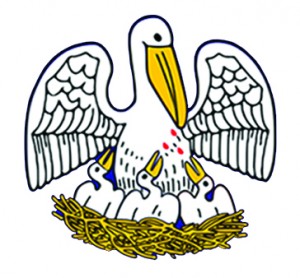 The social studies project of a 14-year-old stemmed a change in the Louisiana state flag design. In 2006, Joseph Louviere, an eighth grader from Houma, covered the variations of designs on the Louisiana state flag.
The social studies project of a 14-year-old stemmed a change in the Louisiana state flag design. In 2006, Joseph Louviere, an eighth grader from Houma, covered the variations of designs on the Louisiana state flag.
Louviere questioned the disappearance of blood drops that were once on the mother pelican.
“It’s been off and on through history,” Louviere said.
The blood represents Louisiana’s willingness to sacrifice itself for the people of the state.
Since 1912, a mother pelican feeding her young has been depicted on the flag.
Yet, over the years the flag has gone from initially having four drops of blood on the pelican’s breast to zero.
It was a change that Louviere questioned.
His family contacted Representative Damon Baldone about the issue, who then drafted the legislation to add three drops back onto the flag.
Louviere was allowed to present his findings to the Louisiana House Judiciary Committee.
After his presentation to the committee, a bill was presented and passed.
LaQuaneisha Smith, a freshman and undeclared major from Shreveport, didn’t even notice the change.
“Truth is, I didn’t even know there were blood drops on the flag to begin with, let alone that they had disappeared.”
She continued, “I will admit though, it sounds nasty but at the same time its cool having blood on the flag. It’s showing everybody Louisiana is a strong state.”
As to why the blood disappeared in the first place, ULM history professor Terry Jones believes that the blood drops were not understood.
“It was probably overlooked. Some people may not have understood why it [blood] was there to begin with,” Jones said.
“I think its better with the blood, it explains the symbolism better.”
There were debates as to why the pelican was initially chosen for the flag.
“A lot of other states made fun of us and wondered why we chose the pelican, and the blood helps shed light on the symbolism,” said Jones.
The bill was passed in 2006 and the new version of the flag was unveiled last year at the swearing in of Lt. Gov.-elect Jay Dardenne.










